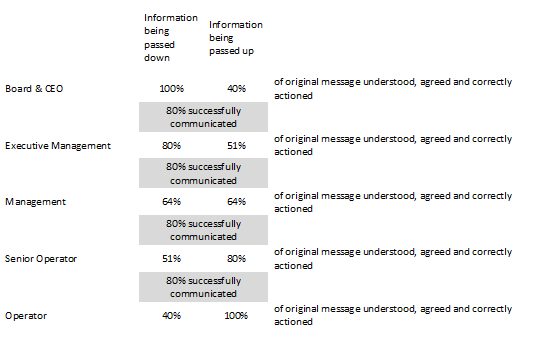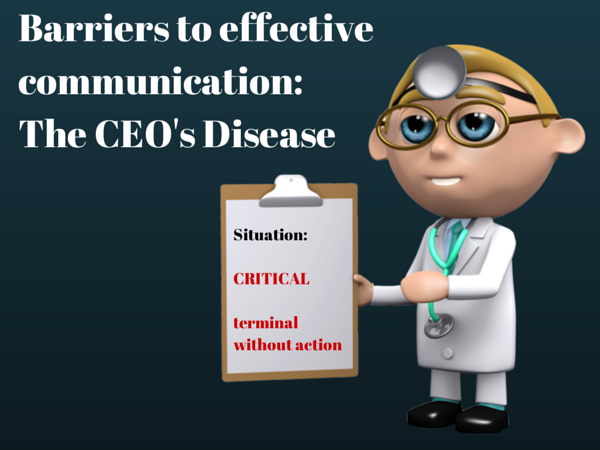Effective Communication is paramount to organisational success; Poor communication can be fatal!
The Problem Dynamic
For over a decade I arm-wrestled with Federal and State contracts in the field of Social Services. Unsurprisingly, considering the complexity of these contracts, I also wrestled with staff, on a daily basis, trying to get them to deliver the contract within the prescribed parameters. I felt I was communicating honestly, openly and clearly, yet I could never find real traction in establishing a platform of performance that was required.
The Diagnosis
In mid 2011, after throwing my hands into the air in resignation, I came across the concept of “The CEO’s Disease”. It was a pivotal moment in my journey towards rebuilding my career and highlighted the significant issues caused by poor communication, whilst giving a diagnosis, a range of symptoms and finally, a cure. As I learned of this putrid disease, I became intimately aware that this disease had run rampant through my previous place of employ. I realised that it was nobody’s fault, it was a disease of unawareness and ineffectiveness, despite extraordinary effort and commitment.
The Symptoms
Effective communication, or lack thereof, can play a very large role in an organisation’s overall performance. “Poor Communication” consistently rates as one of the major disabling factors across vertical and horizontal business structures as indicated by the Sustainable Organisational Culture Survey. Moreover, perception of poor communication channels running vertically through the organisation (ie. from the CEO to the shopfloor) has significant impacts on morale, motivation and effort of people at the lower levels of the organisation. Often, the CEO and senior members of an organisation are unaware of the issues and feelings created by poor communication channels, simply because they don’t experience them personally. This in part, is called The CEO’s Disease. The second part of this disease sits inside the broader portfolio of ‘Communication’, but involves application of ineffective transfer of information, although the reasons behind these ineffective transactions can be complex and numerous. In order for Leadership teams to develop a healthy workplace culture, effective communication is absolutely essential. Understanding the CEO’s disease and its symptoms, problem effects and core issues are an excellent first step in creating such a culture.
Of the eight core organisational competencies measured in the Sustainable Organisational Culture Survey, Communication sits astride the rest, comfortably at number 1. Without a sound platform of communication, it is feasibly difficult to even start measuring the other seven (Fairness, Trust, Power, Truth, Flexibility, Empowerment and Relationships). Consistently organisations applying the survey find that communication is one of the greatest areas of deficit as fed back by staff completing it. As this issue is ‘unpacked’ during the evaluation phase of the process, it becomes clear that the further down the hierarchical food chain people are, the more disenfranchised they feel due to perceptions of poor communication, or lack of inclusion in the communication chain. This has significant impacts on staff morale. Emily Tisdale (recourseresource.com) writes that the first of five steps in staff disengagement is confusion, particularly confusion relating to lack of being informed.
The Vectors
Part 1
CEO’s, Executive teams and Senior Management are often unable to truly understand the confusion (building to frustration, anger and final disappearance) felt by employees below them. The reason for this is simple; they don’t understand it because they don’t experience it! Senior teams expend much time and effort planning, strategizing and evaluating market trends, business performance and future direction. They inherently communicate this information within the group. There is generally discussion, debate and finally consensus (democratically or autocratically) and decisions are made. When fully engaged (or at least witness to) a process, there can be a sense of clarity; “I know the How, Why and When of it…”. This is part 1 of The CEO’s Disease. The inability to understand because of the lack of experience, or even more profoundly, experiencing the polar opposite of the position that needs to be understood.
Part 2
Part 2 of The CEO’s Disease is a product of the ‘HOW’ and ‘WHAT’ of communication. How is the communication taking place? What is being communicated? This part of The Disease is created by communication moving poorly in both directions between levels of the organisation. Let’s use a hypothetical SME business to showcase the problem:
Hypothetical Case study: Internat Drills Australia
Due to ineffective communication as a result of people being “too busy”, only 80% of the information be communicated is successfully received (in either direction).
Using this hypothetical model, information being generated at the top, moving from the Board and CEO down the hierarchy, results in only 40% of the original message being received, understood, agreed to and correctly actioned at the Operator level. The same is true for information flowing upwards. By any measure, a 40% conversion from the origin to the destination is unenviable and could, given constant replication or level of importance, create significant and potentially disastrous outcomes.

The Final Word
The CEO’s Disease is not a disease of the over-confident, arrogant or inane. It is, as cofounder of Business Process Orientation (BPO) Edward Deming describes it; 85% process oriented. Poor communication is a significant barrier to create high performance business culture and it spreads like wildfire throughout Australian business. Executive and Senior teams must bring awareness of The CEO’s Disease and the processes that cause it to the table. Doing so can only move the organisation towards reaching the heights so richly deserved.
Better Communities Consulting invite you to contact us via our website
and start the journey towards creating effective communication techniques and curing the CEO’s Disease for once and for all.
Brad Clarke
Latest posts by Brad Clarke (see all)
- Effective Communication Training – please understand me! - November 13, 2014
- The Triple Bottom Line revisited – growing better (business) communities - October 30, 2014
- That which hides behind the KPI’s: Role Clarity - October 24, 2014



Recent Comments